Of all the forms in which wood can be found, veneer is the least common. It's used for aesthetic reasons, to give a more pleasing look to wood paneling that doesn't fare so well in this respect, but also to increase its strength and durability. Product and interior designers have been discovering it for some time and using it for striking lighting or interior decoration. Read on for more about veneer, how it gets its pattern from the cut, older and newer uses.
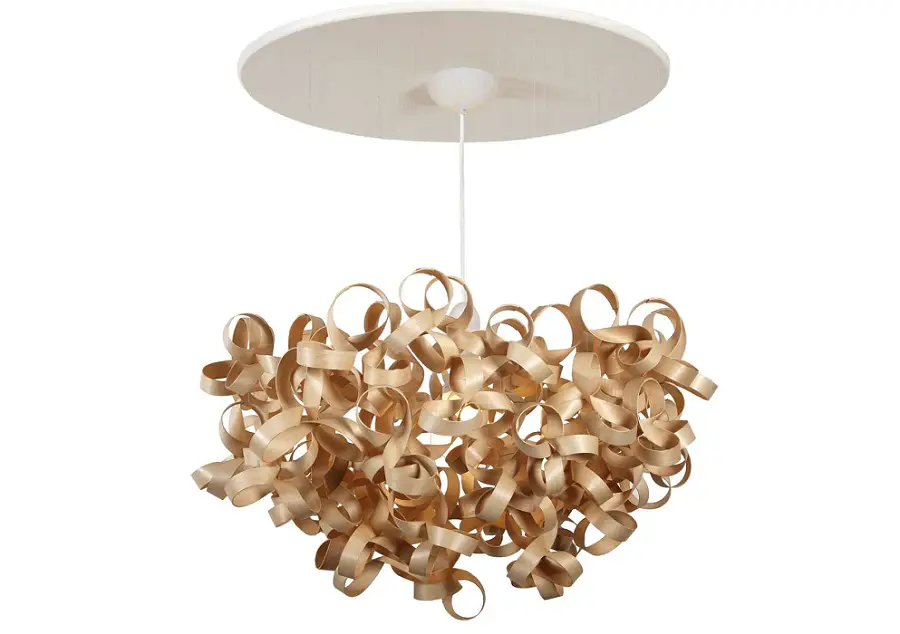
History
For those who think that veneering is a modern invention, you are wrong. Veneered objects have also been found in Egyptian tombs over 4000 years old. More modern evidence of veneering dates back to the 17th century, when better tools made it possible to cut slices of wood of different thicknesses.
In the 18th century renowned furniture manufacturer Chippendale used exotic veneers to increase the value of his furniture. In the early 19th century, plywood made from "slices" of wood was used in the USA to make pianos.
The first patent for veneer dates back to the mid-19th century. Rapid industrial development at the time meant that by the end of the century, plywood was a very affordable material.
Nowadays veneer is used both for plywood and for veneering wood-based panels. The high demand for furniture combined with price pressures has led to the emergence of veneer imitation foils and a whole industry of veneered panels. My view is that wood can be copied but not replaced. Wood offers much more than just a design.
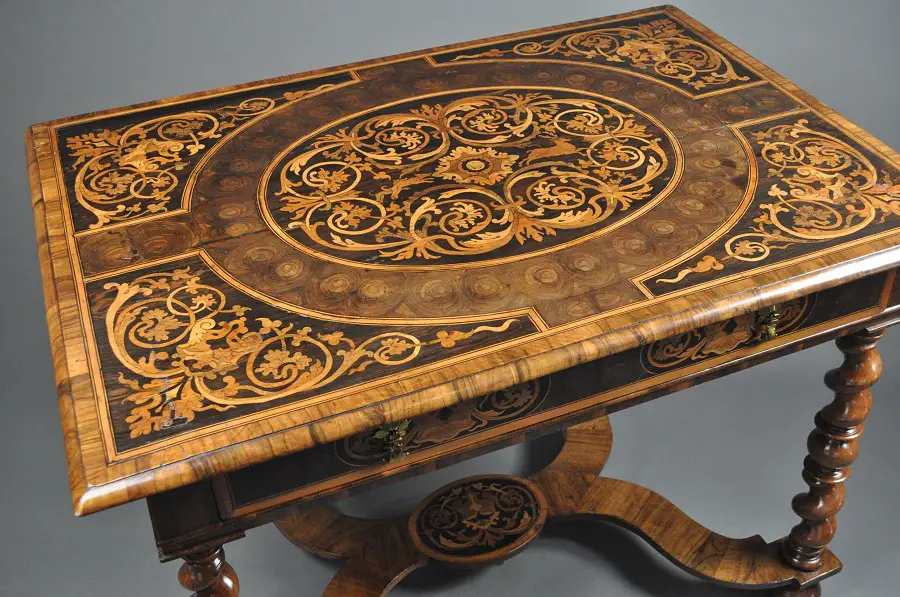
Types of veneer
Depending on use, there are two broad categories of veneers:
- aesthetic veneer
- technical furnishing
Aesthetic supplies are those used to veneer the panels of PAL, MDF, panel, plywood, solid wood. They are very thin, ranging in thickness from 0.55 mm to 1.2 mm. The harder and less porous the species, the thinner the veneer can be cut.
- Walnut, which has a high density and very low permeability, can be cut to a thickness of 0.55 mm.
- Species with medium or low density and not very high porosity, such as aninul, cherry or poplar, are cut in thicknesses of 0.6-0.7 mm.
- Oak and ulmul are hardwoods, but have very large pores. The veneers of these species are 0.7-0.8 mm thick.
- The fairly loose and porous resinous veneers are 1.0 mm thick.
- Aesthetic furnishings can also be obtained from parts of the tree which, due to growth defects, give a spectacular design. This is the case with roots or bumps (burlYou have certainly heard, if not seen, walnut root veneer. These veneers come out a little thicker than those taken from the trunk of the same tree. In the case of walnutThe root veneer is 0.6 mm thick.
Technical supplies are what the plywood is made of. There are face veneers, which are thinner (0,5-1,5 mm) and core veneers, which are between 1,5 and 3 mm thick. Plywood is a wood-derived panel made from an odd number of veneers laid perpendicular to each other. The greater the number of layers, the stronger and stiffer the board.
Plywood can be veneered with aesthetic veneers of other veneers and thus used in furniture production. It is lighter compared to chipboard or MDF.
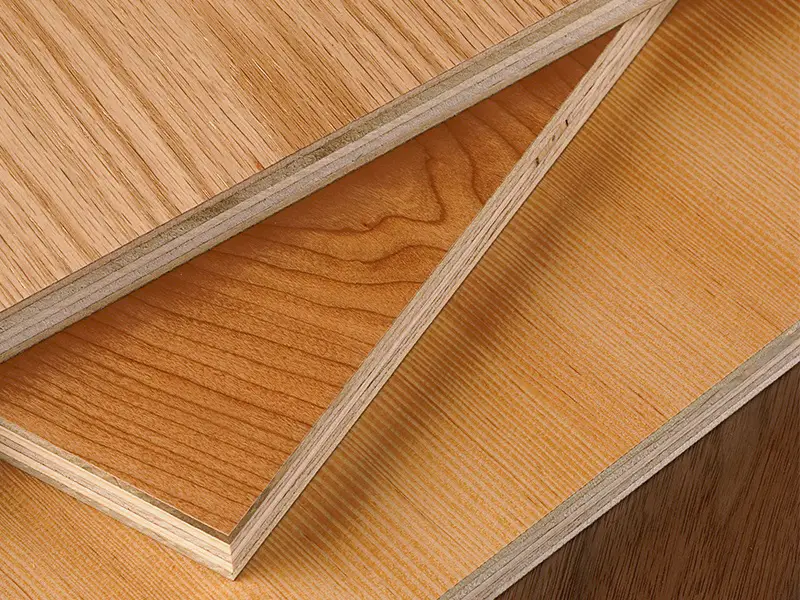
How to get it
The veneers can be obtained from the trunk of the tree, the thick branches that grow immediately from the trunk, the root and the burls. If aesthetic veneers are obtained, the wood is carefully chosen according to size, age and visual characteristics: color, pattern, species, characteristic natural marks or defects. This selection and the way in which the veneers are cut influence the design of the veneers.
Veneer is mainly made from hardwood because it is harder, denser and less permeable. Veneer is also made from resinous woods, especially the harder ones.
The stages the log goes through to the veneer stage are:
- peel
- cutting to length
- plasticisation (steaming, wetting)
- debit
- drying
- cutting to size
In order for veneer sheets to be cut without cracking, the wood must be as plasticized as possible. This is done by dampening and steaming. How long the logs are soaked and steamed depends on the species and thickness. To produce a quality product, the processing must be done fairly quickly - within an hour - after the logs are taken out of the steaming. Plasticizing can also be done with high-frequency current (HF), but few use it because it is expensive.
There are 4 main types of veneers:
- by scrolling
- by tangential cutting
- by radial cutting
- by parallel radial cutting
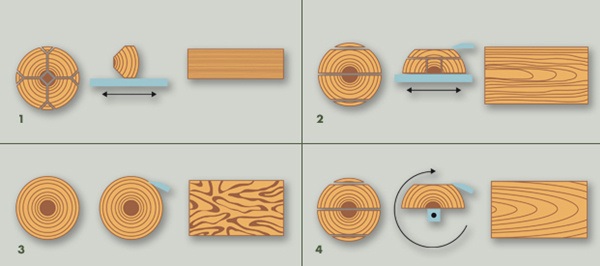
Via running technical veneers are obtained. Basically the whole log is rotated by a knife resulting in a continuous sheet of veneer. There is no particular pattern to the sheet, which is cut parallel to the annual rings. The method is very economical with minimal waste. After unwinding, the sheets are cut to size and dried.
There is also a method by which log halves are 'unrolled'. The half is mounted on a device that rotates by passing a knife. This produces veneer sheets that are larger than other types of cutting, but smaller than the traditional scroll and with a rounder flader (cathedral grain) pattern.
Tangential cutting parallel to the center of the log. The result is those flanges I mentioned above, but sharper. They are highly prized veneers for their specific natural design.
Radial plane cutting The knife is mounted at a 90° angle to the annual rings. The result is a pattern of parallel lines, the lines representing the annular rings.
Radial cutting is done in approximately the same way as the flat one except that the angle is not exactly 90°. It is a cut specific to oak, which brings out the medullary rays that appear mirror-like.
After cutting, the veneers are dried because the moisture content of the wood is increased as a result of plasticizing treatments. They are then cut and arranged in bundles. The wood is always numbered so that it knows where it comes from and can be matched. So in the end you end up with veneer bundles from the same piece of wood.
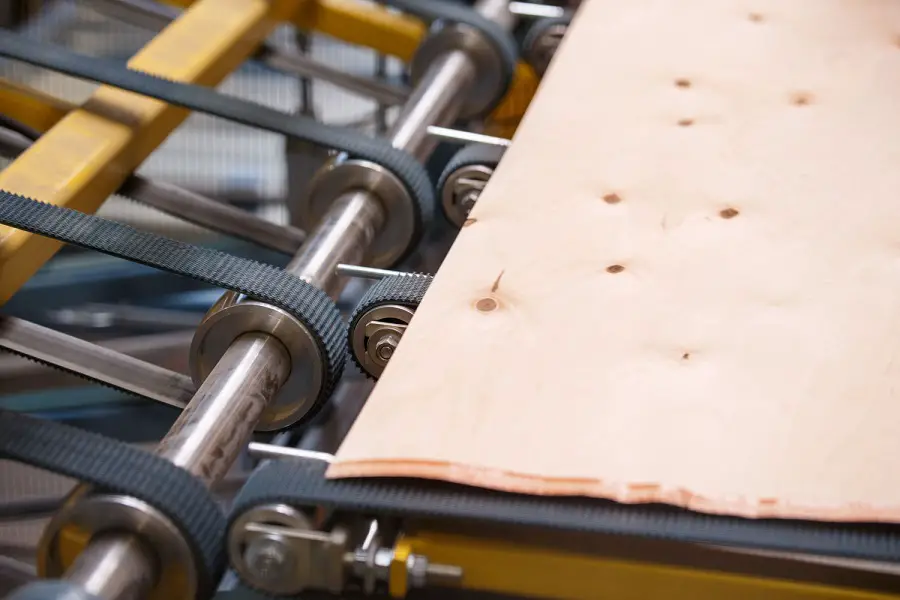
Use of veneers
Veneers enhance wood-based panels. They are mostly used to veneer chipboard or MDF panels. But not only for them. It may seem strange, but solid wood panels are also veneered. There are situations when this is needed to make pieces of furniture easier to use. For example, a large piece of oak or another high-density species is very heavy.
About plywood I want to emphasize that it is preferred to other types of panels because it is composed of several layers of wood. It looks good, it is easy to work and finish, it can be veneered with special wood veneers, and it is much lighter than chipboard or MDF.
Supplies are used to obtain inlays. In the past, it was a technique used to refinish pieces of furniture. Now, as it's a very painstaking and painstaking operation, few people dare to do it anymore. Especially since the advent CNCs made it easy to "draw" different patterns on wood without much effort.
Defective veneers result in reconstituted veneers which we have talked about on another occasion. The difference between them is visible to a connoisseur, but the refurbished one is also wood.
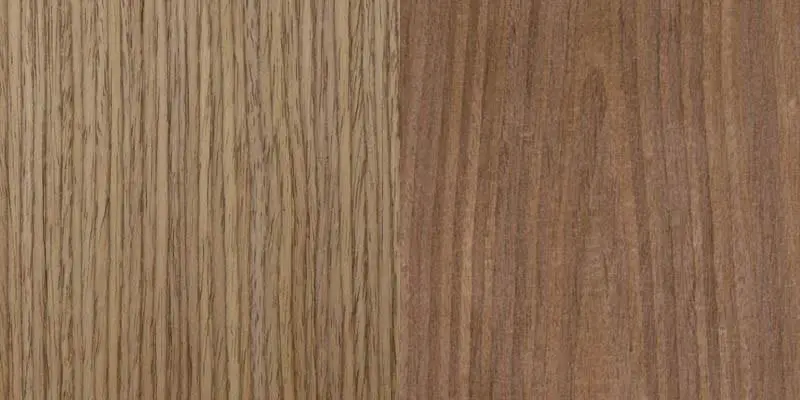
Their very beautiful natural design, great colors and the fact that they can be easily shaped attracted designers' attention to veneers. This is how veneer lampshades came about. And they didn't stop there. They've used them to decorate ceilings, create screens or decorate walls. Such veneers are treated to make them more plastic or easier to shape.
A very spectacular type of veneer is that used for decorating jewelry boxes using the Japanese Yosegi technique. The resulting veneers have very different patterns and are as thin as a thin sheet of paper. But more about Yosegi Art in a future post.
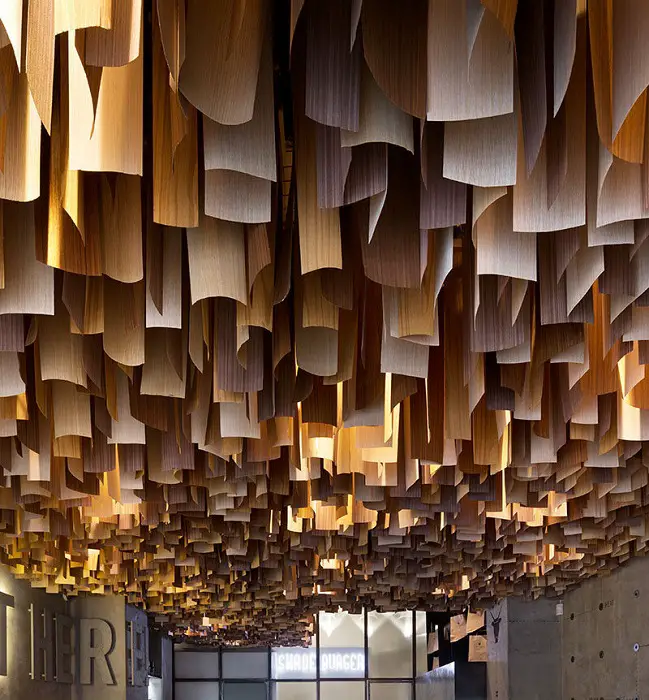





















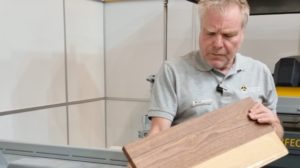
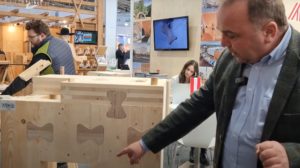
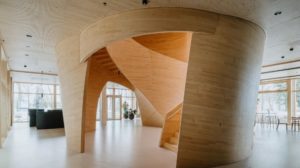









where can I buy about 3 square meters?
Hello.
As far as I know, from Holver you can get small quantities of materials (veneer, wood).
All the best!
Can you present the manual technique of applying a veneer (walnut, for example) on a linden board or something else? Do you use "prenadez" (aderpren etc.) or something else? And how? Thank you.
Hello!
There will be a hand veneering article soon.
A few pointers until then:
- it is very important that no air is left between the veneer and the board. To do this, after the veneer is placed on the board, it can be ironed (cold) to remove any air bubbles. I have seen in US and Canadian materials that they use vacuum bags. We have not seen them;
- if the panel is large and more veneer sheets are needed they should be cut to size and glued with paper tape. The veneer will not move and the tape is easily removed at the end;
- the most commonly used adhesive is polyvinyl acetate (aracite type). Prenadez is no longer recommended because it is toxic.
- the adhesive is applied with a trowel on the panel in equal quantity, then the veneer sheet is put on and the air bubbles are removed. Place a piece of plywood on top and clamp everything together. Leave the adhesive to react for as long as the manufacturer recommends. Use cold reacting adhesive.
- if you use a glue similar to pre-glue, you have to leave some time (15-20 min) for the solvent to evaporate. Then you can put the veneer over the panel and you have to be careful because it reacts very quickly. For this reason I do not recommend such an adhesive.
- finally remove the paper tape and sand the surface.
Good luck!
Don't forget to subscribe to the printed Wood Magazine! For only 58 lei/year you can find out news in the field, discover craft ideas or trade secrets. We remind you that the content in the printed magazine is different from the one on the website. Details in the link below.
Thank you!https://revistadinlemn.ro/product/abonament-revista-din-lemn/
Handshake and a sincere Happy Birthday!
Please tell me how to straighten some mahogany and linden veneer that has, over time, curled irregularly.
Thank you!
Good evening!
I wish you a Happy New Year, with health and joy!
If the veneer is not glued (loose veneer sheets), you need to steam it a little (you can leave it in the bathroom when it is steaming) to increase its humidity and restore its elasticity. Then leave it to dry between two straight boards (or other such device that also absorbs moisture).
If the veneer is glued to the ceve it means that it has peeled off in the area where it has been waved. A small notch should be made in that area, glue applied and pressed. The excess adhesive is wiped off and a flat weight is placed on top until the adhesive strengthens.
Good luck!
Hello, where can I find 1.5 mm thick HDF, I need a larger quantity, thanks
Good evening.
As far as I remember, EGGER has HDF on offer.
All the best!
Good evening,
I received a professional table pallet wood, pallet made of 7 layers of material. On the surface it has a layer of "tongue". Normally, this veneer has a beige color. In my case, the tongue veneer turned a reddish, uneven shade.... Can this happen due to natural causes?
Thank you
Hello!
The natural colour of wood is sensitive to light and UV radiation. Most species begin to change their natural colour as soon as they are cut. It is possible that wood may have changed its natural colour if it has been in the sun without being protected with UV-absorbing protective materials.
Another cause may be water staining.
However, it is not mandatory that this is a maintenance or usage fault. There are natural defects of wood, including different and uneven colouring. Sometimes these natural defects make the wood unique.
All the best!
[...] The applied veneer was in a rather poor condition which, at first, I thought had to be replaced. I did, however, decide to try remediating it by colour grouting (a dark/dark walnut combination), and in places I used resin where there were grooves too deep for the grout to be effective. [...]